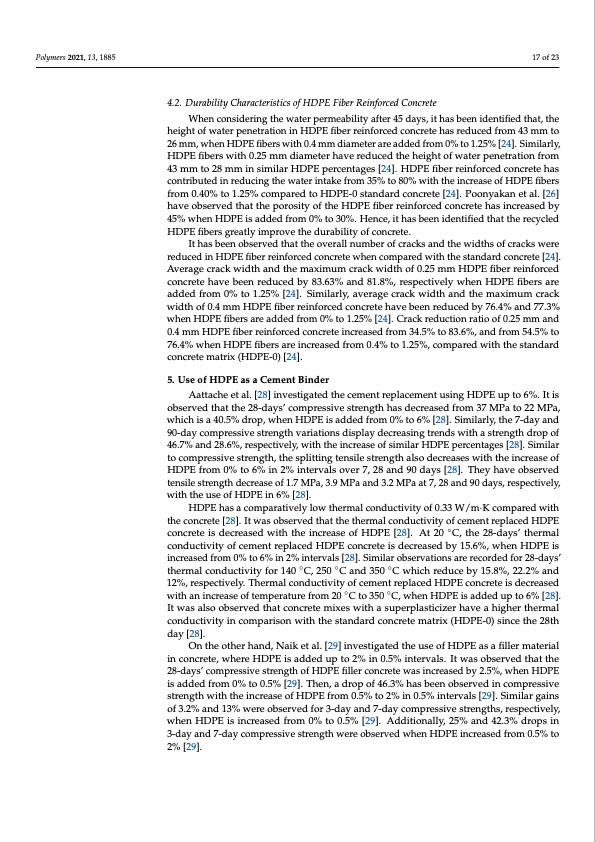
PDF Publication Title:
Text from PDF Page: 017
Polymers 2021, 13, 1885 17 of 23 4.2. Durability Characteristics of HDPE Fiber Reinforced Concrete When considering the water permeability after 45 days, it has been identified that, the height of water penetration in HDPE fiber reinforced concrete has reduced from 43 mm to 26 mm, when HDPE fibers with 0.4 mm diameter are added from 0% to 1.25% [24]. Similarly, HDPE fibers with 0.25 mm diameter have reduced the height of water penetration from 43 mm to 28 mm in similar HDPE percentages [24]. HDPE fiber reinforced concrete has contributed in reducing the water intake from 35% to 80% with the increase of HDPE fibers from 0.40% to 1.25% compared to HDPE-0 standard concrete [24]. Poonyakan et al. [26] have observed that the porosity of the HDPE fiber reinforced concrete has increased by 45% when HDPE is added from 0% to 30%. Hence, it has been identified that the recycled HDPE fibers greatly improve the durability of concrete. It has been observed that the overall number of cracks and the widths of cracks were reduced in HDPE fiber reinforced concrete when compared with the standard concrete [24]. Average crack width and the maximum crack width of 0.25 mm HDPE fiber reinforced concrete have been reduced by 83.63% and 81.8%, respectively when HDPE fibers are added from 0% to 1.25% [24]. Similarly, average crack width and the maximum crack width of 0.4 mm HDPE fiber reinforced concrete have been reduced by 76.4% and 77.3% when HDPE fibers are added from 0% to 1.25% [24]. Crack reduction ratio of 0.25 mm and 0.4 mm HDPE fiber reinforced concrete increased from 34.5% to 83.6%, and from 54.5% to 76.4% when HDPE fibers are increased from 0.4% to 1.25%, compared with the standard concrete matrix (HDPE-0) [24]. 5. Use of HDPE as a Cement Binder Aattache et al. [28] investigated the cement replacement using HDPE up to 6%. It is observed that the 28-days’ compressive strength has decreased from 37 MPa to 22 MPa, which is a 40.5% drop, when HDPE is added from 0% to 6% [28]. Similarly, the 7-day and 90-day compressive strength variations display decreasing trends with a strength drop of 46.7% and 28.6%, respectively, with the increase of similar HDPE percentages [28]. Similar to compressive strength, the splitting tensile strength also decreases with the increase of HDPE from 0% to 6% in 2% intervals over 7, 28 and 90 days [28]. They have observed tensile strength decrease of 1.7 MPa, 3.9 MPa and 3.2 MPa at 7, 28 and 90 days, respectively, with the use of HDPE in 6% [28]. HDPE has a comparatively low thermal conductivity of 0.33 W/m·K compared with the concrete [28]. It was observed that the thermal conductivity of cement replaced HDPE concrete is decreased with the increase of HDPE [28]. At 20 ◦C, the 28-days’ thermal conductivity of cement replaced HDPE concrete is decreased by 15.6%, when HDPE is increased from 0% to 6% in 2% intervals [28]. Similar observations are recorded for 28-days’ thermal conductivity for 140 ◦C, 250 ◦C and 350 ◦C which reduce by 15.8%, 22.2% and 12%, respectively. Thermal conductivity of cement replaced HDPE concrete is decreased with an increase of temperature from 20 ◦C to 350 ◦C, when HDPE is added up to 6% [28]. It was also observed that concrete mixes with a superplasticizer have a higher thermal conductivity in comparison with the standard concrete matrix (HDPE-0) since the 28th day [28]. On the other hand, Naik et al. [29] investigated the use of HDPE as a filler material in concrete, where HDPE is added up to 2% in 0.5% intervals. It was observed that the 28-days’ compressive strength of HDPE filler concrete was increased by 2.5%, when HDPE is added from 0% to 0.5% [29]. Then, a drop of 46.3% has been observed in compressive strength with the increase of HDPE from 0.5% to 2% in 0.5% intervals [29]. Similar gains of 3.2% and 13% were observed for 3-day and 7-day compressive strengths, respectively, when HDPE is increased from 0% to 0.5% [29]. Additionally, 25% and 42.3% drops in 3-day and 7-day compressive strength were observed when HDPE increased from 0.5% to 2% [29].PDF Image | Engineering Performance of Concrete Incorporated with Recycled HDPE

PDF Search Title:
Engineering Performance of Concrete Incorporated with Recycled HDPEOriginal File Name Searched:
6b2d9750f7cf13ccb459f476e519aec39ce1.pdfDIY PDF Search: Google It | Yahoo | Bing
Development of a solar powered Electric Ship The Electricship website originally started off as a project to develop a comprehensive renewable, affordable, modular electric ship... More Info
Modular Boat Hull Composite The case for a unsinkable, modular composite hybrid boat hull... More Info
MS Burgenstock Hybrid Electric Catamaran Lake Lucerne Unique shuttle servicing Lucerne to the Burgenstock Resort... More Info
Ground Power Unit GPU Powered by Lithium Ion Batteries The goal of the Ground Power Unit is to provide a readily accessible, modular, ready-to-power solution for remote power... More Info
| CONTACT TEL: 608-238-6001 Email: greg@electricship.com | RSS | AMP |